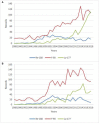Rhenium-188 Labeled Radiopharmaceuticals: Current Clinical Applications in Oncology and Promising Perspectives
- PMID: 31259173
- PMCID: PMC6587137
- DOI: 10.3389/fmed.2019.00132
Rhenium-188 Labeled Radiopharmaceuticals: Current Clinical Applications in Oncology and Promising Perspectives
Abstract
Rhenium-188 (188Re) is a high energy beta-emitting radioisotope with a short 16.9 h physical half-life, which has been shown to be a very attractive candidate for use in therapeutic nuclear medicine. The high beta emission has an average energy of 784 keV and a maximum energy of 2.12 MeV, sufficient to penetrate and destroy targeted abnormal tissues. In addition, the low-abundant gamma emission of 155 keV (15%) is efficient for imaging and for dosimetric calculations. These key characteristics identify 188Re as an important therapeutic radioisotope for routine clinical use. Moreover, the highly reproducible on-demand availability of 188Re from the 188W/188Re generator system is an important feature and permits installation in hospital-based or central radiopharmacies for cost-effective availability of no-carrier-added (NCA) 188Re. Rhenium-188 and technetium-99 m exhibit similar chemical properties and represent a "theranostic pair." Thus, preparation and targeting of 188Re agents for therapy is similar to imaging agents prepared with 99mTc, the most commonly used diagnostic radionuclide. Over the last three decades, radiopharmaceuticals based on 188Re-labeled small molecules, including peptides, antibodies, Lipiodol and particulates have been reported. The successful application of these 188Re-labeled therapeutic radiopharmaceuticals has been reported in multiple early phase clinical trials for the management of various primary tumors, bone metastasis, rheumatoid arthritis, and endocoronary interventions. This article reviews the use of 188Re-radiopharmaceuticals which have been investigated in patients for cancer treatment, demonstrating that 188Re represents a cost effective alternative for routine clinical use in comparison to more expensive and/or less readily available therapeutic radioisotopes.
Keywords: Rhenium-188; bone pain palliation; oncology; peptides; radioembolization; radionuclide therapy; radiopharmaceuticals.
Figures










References
Publication types
LinkOut - more resources
Full Text Sources

